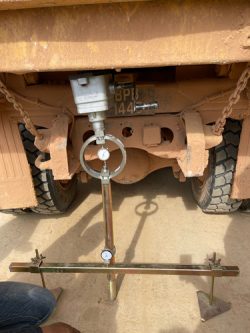CBR Values VS Hveem R-Values In Roadway Design
 When it comes to roadway design and construction, engineers and designers rely on various parameters to ensure the durability, safety, and performance of the road. Two commonly used measurements in roadway design are CBR (California Bearing Ratio) values and Hveem R-Values. In this blog, we will explore the differences between CBR values and Hveem R-Values and discuss their significance in roadway design.
When it comes to roadway design and construction, engineers and designers rely on various parameters to ensure the durability, safety, and performance of the road. Two commonly used measurements in roadway design are CBR (California Bearing Ratio) values and Hveem R-Values. In this blog, we will explore the differences between CBR values and Hveem R-Values and discuss their significance in roadway design.
1. Understanding CBR Values:
CBR values are used to assess the strength of subgrade soils, which play a critical role in supporting the road pavement. CBR is a measure of the load-bearing capacity of the soil, comparing its strength to that of a standard crushed stone material. The CBR value is expressed as a percentage, with higher values indicating better soil strength. It helps engineers determine the thickness of the pavement and design suitable pavement structures based on the soil conditions.
2. Significance of CBR Values:
CBR values are vital in determining the appropriate pavement design for different soil conditions. Soils with high CBR values require less pavement thickness since they can withstand higher loads without significant deformation. In contrast, soils with low CBR values need thicker pavement layers to distribute the load and prevent deformation. By understanding the CBR values of subgrade soils, engineers can optimize the pavement design and enhance the overall road performance.
3. Introduction to Hveem R-Values:
While CBR values offer insights into subgrade soil strength, Hveem R-Values focus on the moisture susceptibility and stability of asphalt mixes. Hveem R-Values are determined through laboratory testing, simulating the effects of moisture on the asphalt pavement. The R-Value is a measure of the asphalt mix’s resistance to deformation and cracking resulting from the presence of moisture.
4. Evaluating Moisture Susceptibility:
Moisture can significantly impact the stability and durability of asphalt pavement. Hveem R-Values help engineers understand how susceptible an asphalt mix is to moisture-related damage. Higher R-Values indicate better resistance to moisture-induced distress, such as rutting and cracking. By assessing Hveem R-Values, engineers can select appropriate asphalt mixtures and design strategies to mitigate the adverse effects of moisture.
5. Complementary Role of CBR Values and Hveem R-Values:
CBR values and Hveem R-Values serve different purposes in roadway design, but they are complementary to each other. While CBR values provide information about the strength of subgrade soils, Hveem R-Values assess the performance of asphalt mixes under moisture conditions. Together, these measurements help engineers develop comprehensive and robust designs that account for both subgrade strength and pavement stability.
6. Integration into Roadway Design:
In road construction projects, CBR values and Hveem R-Values are used in specific design and analysis methods. For example, the AASHTO (American Association of State Highway and Transportation Officials) design method incorporates CBR values to determine suitable pavement thickness based on expected traffic loads. Similarly, Hveem R-Values are used in the Superpave system developed by the Asphalt Institute, which considers the effects of moisture on asphalt performance. These values play a crucial role in the selection of materials, pavement design, and overall pavement performance evaluation.
Summary:
CBR values and Hveem R-Values are essential parameters in roadway design, each providing valuable insights into different aspects of road performance. CBR values assess soil strength and help determine appropriate pavement thickness, while Hveem R-Values evaluate the moisture susceptibility of asphalt mixes. By considering both measurements in the design process, engineers can develop resilient and long-lasting roadways that meet the demands of expected traffic loads and withstand the effects of moisture. A comprehensive understanding of CBR values and Hveem R-Values allows for informed decision-making in roadway design, ultimately resulting in safer and more durable roads.
Need Engineers and Designers in Hudson, CO?
Since 2006, High Plains Engineering & Consulting, LLC has been a civil and structural engineering company in Fort Lupton and the surrounding areas. We provide sensible solutions to geotechnical, structural, environmental, and civil engineering challenges. Our office provides practical expertise backed by diverse design resources to get the job done cost-effectively and efficiently with sustainability in mind. We offer various services for commercial, residential, and agricultural properties like soil testing, percolation testing, and foundation and septic design for new construction. Once that is taken care of we also offer services for floor framing, garage plans, house plans, site plans, and inspection services. Call us today for an appointment!
Categorised in: Roadway Design

 HPEC is an active member of CAGE
HPEC is an active member of CAGE